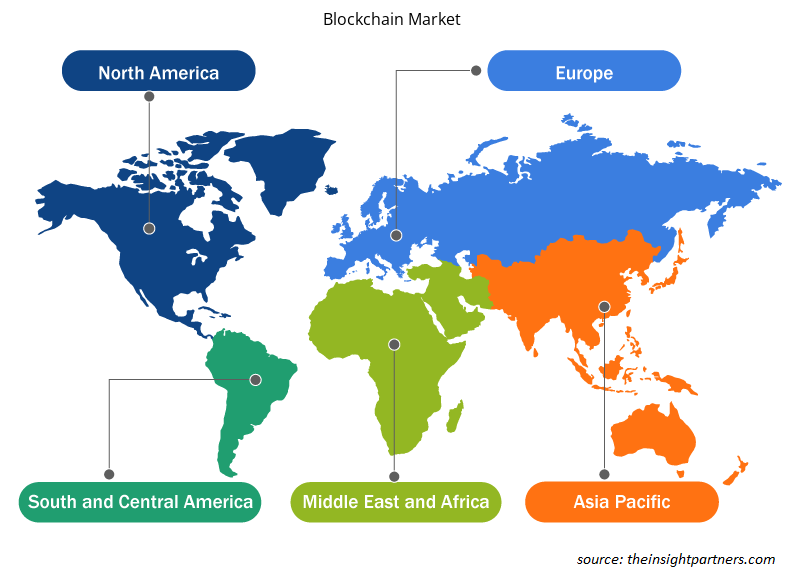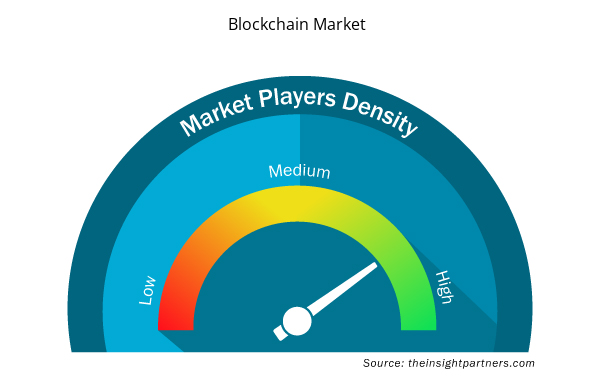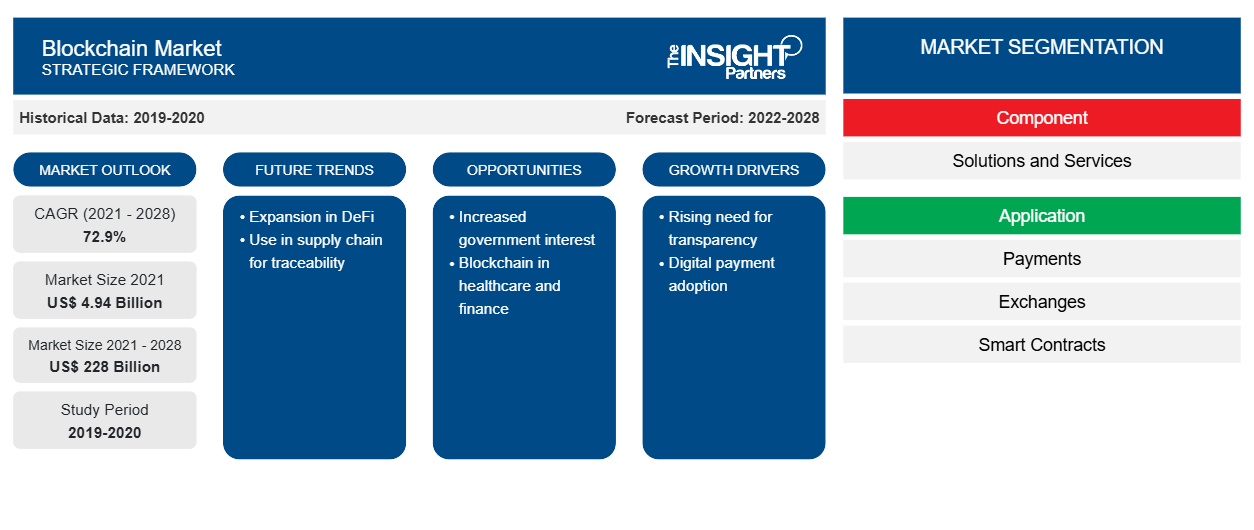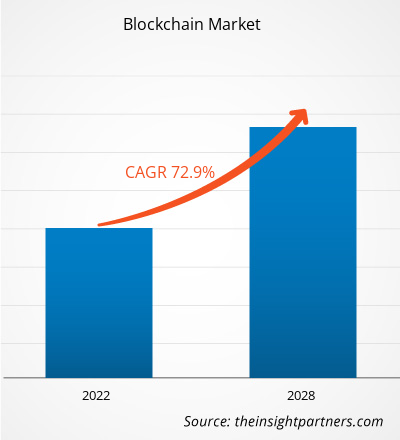Le marché de la blockchain devrait passer de 4 935,0 millions de dollars américains en 2021 à 227 996,6 millions de dollars américains d'ici 2028 ; il devrait croître à un TCAC de 72,9 % de 2021 à 2028.
La technologie Blockchain et ses applications dans le secteur bancaire, des services financiers et des assurances (BFSI) ont suscité beaucoup d'attention ces dernières années, principalement en raison de sa capacité à transformer les fondements et les modèles commerciaux des industries existantes. Actuellement, outre les applications de cryptomonnaie , les autres principales applications pratiques de la Blockchain se situent toujours dans le secteur bancaire et financier. Cependant, diverses entreprises et institutions développent rapidement des solutions basées sur la Blockchain pour résoudre des problèmes commerciaux complexes. En termes généraux, la Blockchain est un sous-ensemble d'une technologie de registre distribué (DLT) plus large et combine trois concepts importants : la cryptographie, les contrats intelligents et la conception de registres distribués. La technologie de registre distribué (DLT) est une approche émergente qui enregistre et partage des données dans divers magasins de données/registres. La DLT facilite l'enregistrement, le partage et la synchronisation des transactions et des données sur un réseau distribué de différents participants au réseau.
Le marché mondial de la blockchain devrait connaître une croissance très élevée dans un avenir proche. Les principaux facteurs moteurs contribuant à la croissance du marché comprennent l'adoption généralisée des solutions Blockchain dans le secteur BFSI ; des avantages tels qu'une plus grande transparence, une plus grande efficacité opérationnelle et des économies de coûts substantielles ; et une augmentation du nombre de startups innovantes. Au cours de la période de prévision, des tendances telles que l'augmentation du soutien et des initiatives du gouvernement et une combinaison de la blockchain et de l'intelligence artificielle pour des applications avancées devraient offrir des opportunités intéressantes aux acteurs opérant sur le marché de la blockchain.
Personnalisez ce rapport en fonction de vos besoins
Vous bénéficierez d'une personnalisation gratuite de n'importe quel rapport, y compris de certaines parties de ce rapport, d'une analyse au niveau des pays, d'un pack de données Excel, ainsi que de superbes offres et réductions pour les start-ups et les universités.
- Obtenez les principales tendances clés du marché de ce rapport.Cet échantillon GRATUIT comprendra une analyse de données, allant des tendances du marché aux estimations et prévisions.
Impact de la pandémie de COVID-19 sur le marché de la blockchain
Alors que la pandémie de COVID-19 a posé des problèmes importants aux organisations du monde entier, le marché de la blockchain a connu une croissance constante pendant la crise. Plus important encore, tout au long de l'épidémie, les professionnels de la santé ont commencé à utiliser des chats, des e-mails, des téléphones et des conversations vidéo pour traiter les patients à distance, empêchant ainsi la propagation du virus. L'utilisation d' outils de test de pénétration pour des transactions en ligne sécurisées et des données conversationnelles a augmenté en raison de cela. L'adoption du marché de la blockchain par diverses entreprises pour offrir une sécurité optimale dans un environnement chaotique est également un élément crucial qui stimule le marché vertical de la blockchain. La pandémie de COVID-19 a eu un impact sur tous les aspects de la société, y compris les particuliers et les entreprises. L'écosystème Internet est devenu de plus en plus important à l'échelle mondiale. La dépendance aux entreprises en ligne s'est considérablement accrue en raison de l'épidémie de COVID-19. Internet est utilisé par les BFSI, les soins de santé et les sciences de la vie, la fabrication, la vente au détail, le transport et la logistique, et d'autres industries pour fournir des services essentiels aux consommateurs. La demande de blockchain a augmenté parmi les fournisseurs. Divers gouvernements et organismes de réglementation ont forcé les organisations publiques et privées à accepter de nouvelles techniques de télétravail et de préservation de la distance sociale à la suite de la pandémie de COVID-19. Depuis lors, les pratiques commerciales numériques et l’utilisation des courriers électroniques sur les serveurs domestiques sont devenues le nouveau plan de continuité des activités (PCA) pour diverses entreprises.
Informations sur le marché de la blockchain
Les principales industries du monde entier, notamment les secteurs des BFSI, de la vente au détail, de la logistique et des transports, de la santé, de l'automobile, des médias et du divertissement et des pouvoirs publics, adoptent et investissent dans des technologies de rupture telles que la blockchain, l'intelligence artificielle, l'Internet des objets (IoT), le big data et l'analyse prédictive . L'adoption croissante de la technologie Blockchain est motivée par les cas d'utilisation réussis et les preuves de concepts Blockchain dans divers secteurs, qui ont abouti à une transparence accrue, à une efficacité opérationnelle améliorée et à une réduction des coûts. La nature des entreprises devient très compétitive dans tous les secteurs du monde et, pour être compétitives efficacement, les entreprises s'appuient aujourd'hui sur l'intégration de la technologie dans diverses fonctions commerciales pour accroître la transparence et l'efficacité opérationnelles.
La blockchain a de nombreuses applications dans le secteur financier, notamment dans les domaines des paiements, des marchés financiers, des services commerciaux, de la gestion des investissements et du patrimoine , ainsi que des échanges de valeurs mobilières et de matières premières. Les économies de coûts substantielles sont l'un des principaux moteurs de l'adoption croissante de la blockchain dans ce secteur.
L'utilisation de la technologie Blockchain a rendu les transactions plus transparentes dans les principaux secteurs d'activité. Cette transparence permet d'éviter la fraude et les activités non autorisées dans des secteurs tels que les services financiers, le gouvernement et la santé, où des données sensibles sont partagées entre les participants. La blockchain rationalise et automatise les processus traditionnels, lourds en papier, qui prennent du temps et sont sujets aux erreurs humaines. Cela rend les transactions rapides et efficaces, augmentant ainsi l'efficacité opérationnelle.
La réduction des coûts et les économies sont des priorités majeures pour toute entreprise. La blockchain élimine les tiers ou intermédiaires inutiles pour réduire le temps et les coûts. Avec tous ces avantages, la blockchain permet aux entreprises d'améliorer l'efficacité opérationnelle, la transparence, de réduire les coûts d'exploitation et, ainsi, de les aider à améliorer la qualité du service et l'expérience client.
Informations sur les segments de composants
En fonction des composants, le marché de la blockchain peut être divisé en services et solutions. Le segment des solutions a dominé le marché de la blockchain. L'adoption croissante des solutions blockchain en raison de leur capacité à offrir plus de transparence dans la gestion des transactions financières en bitcoin, ainsi que la numérisation croissante, propulsent le marché de la blockchain vers l'avant. Les clients peuvent utiliser la plateforme blockchain du marché pour créer des environnements blockchain privés, publics et basés sur des consortiums et construire leurs propres applications et solutions blockchain. Les personnes, les produits, les applications et les services peuvent interagir sur le réseau blockchain, les fournisseurs de cloud et les entreprises utilisant ces plateformes.
Aperçu régional du marché de la blockchain
Les tendances régionales et les facteurs influençant le marché de la blockchain tout au long de la période de prévision ont été expliqués en détail par les analystes d’Insight Partners. Cette section traite également des segments et de la géographie du marché de la blockchain en Amérique du Nord, en Europe, en Asie-Pacifique, au Moyen-Orient et en Afrique, ainsi qu’en Amérique du Sud et en Amérique centrale.

- Obtenez les données régionales spécifiques au marché de la blockchain
Portée du rapport sur le marché de la blockchain
| Attribut de rapport | Détails |
|---|---|
| Taille du marché en 2021 | 4,94 milliards de dollars américains |
| Taille du marché d'ici 2028 | 228 milliards de dollars américains |
| Taux de croissance annuel moyen mondial (2021-2028) | 72,9% |
| Données historiques | 2019-2020 |
| Période de prévision | 2022-2028 |
| Segments couverts | Par composant
|
| Régions et pays couverts | Amérique du Nord
|
| Leaders du marché et profils d'entreprises clés |
|
Densité des acteurs du marché de la blockchain : comprendre son impact sur la dynamique des entreprises
Le marché de la blockchain connaît une croissance rapide, tirée par la demande croissante des utilisateurs finaux en raison de facteurs tels que l'évolution des préférences des consommateurs, les avancées technologiques et une plus grande sensibilisation aux avantages du produit. À mesure que la demande augmente, les entreprises élargissent leurs offres, innovent pour répondre aux besoins des consommateurs et capitalisent sur les tendances émergentes, ce qui alimente davantage la croissance du marché.
La densité des acteurs du marché fait référence à la répartition des entreprises ou des sociétés opérant sur un marché ou un secteur particulier. Elle indique le nombre de concurrents (acteurs du marché) présents sur un marché donné par rapport à sa taille ou à sa valeur marchande totale.
Les principales entreprises opérant sur le marché de la blockchain sont :
- Société IBM
- Microsoft Corporation
- Accenture
- Amazone
- SAP SE
Avis de non-responsabilité : les sociétés répertoriées ci-dessus ne sont pas classées dans un ordre particulier.

- Obtenez un aperçu des principaux acteurs du marché de la blockchain
Informations sur les segments d'application
Le marché mondial de la blockchain est segmenté en paiements, échanges, contrats intelligents, documentation, identité numérique, gouvernance, risque et conformité, etc. Le segment des paiements a dominé le marché de la blockchain. Les autres segments comprennent le vote numérique, le covoiturage, la publicité et bien d'autres. La blockchain réduit les coûts, augmente la sécurité, augmente la transparence et diminue le temps de transaction tout en réduisant le besoin d'un tiers de confiance. La blockchain gère un ensemble variable de règles et de configurations. Une application telle que les contrats intelligents peut considérablement améliorer l'efficacité des processus, la fiabilité, la transparence et réduire les risques. Les utilisations potentielles de la blockchain sont variées et larges, et la technologie devient de plus en plus répandue.
Informations sur les segments de type vertical de l'industrie
La blockchain est un registre distribué capable de vérifier et d'enregistrer automatiquement un volume élevé de transactions numériques, quel que soit l'emplacement. À mesure que les startups utilisent la technologie blockchain pour améliorer la transparence sur le réseau d'informations numériques, elles font connaître la technologie blockchain dans divers secteurs. Sur la base du secteur vertical, le marché mondial de la blockchain est classé en BFSI, commerce de détail, gouvernement, transport et logistique, santé, automobile, médias et divertissement, etc. Les autres segments comprennent la fabrication, l'immobilier, l'électricité et les services publics, les télécommunications et les sports.
Les acteurs du marché de la blockchain se concentrent sur les innovations et les développements de nouveaux produits en intégrant des technologies et des fonctionnalités avancées pour être compétitifs. Par exemple, en 2019, Carrefour et Nestlé se sont associés à IBM pour utiliser la technologie blockchain dans les catégories alimentaires. Ce partenariat permettrait une expansion rapide d'un réseau basé sur la blockchain qui apporte plus de transparence à la chaîne d'approvisionnement alimentaire mondiale des détaillants, des producteurs, des grossistes, des transformateurs, des distributeurs et des fabricants.
Marché de la blockchain – Profils d’entreprises
- Société IBM
- Microsoft Corporation
- Accenture
- Amazone
- SAP Se
- Hewlett Packard Enterprise Development LP (HPE)
- Société Oracle
- Société Intel
- Ondulation
- Groupe Bitfury
- Analyse historique (2 ans), année de base, prévision (7 ans) avec TCAC
- Analyse PEST et SWO
- Taille du marché Valeur / Volume - Mondial, Régional, Pays
- Industrie et paysage concurrentiel
- Ensemble de données Excel



Report Coverage
Revenue forecast, Company Analysis, Industry landscape, Growth factors, and Trends

Segment Covered
This text is related
to segments covered.

Regional Scope
North America, Europe, Asia Pacific, Middle East & Africa, South & Central America

Country Scope
This text is related
to country scope.
Questions fréquemment posées
Extensive Adoption of Blockchain Solutions in BFSI Industry Vertical
High Transparency and Operational Efficiency with Substantial Cost Savings
The rising Government Support and Initiatives Worldwide is anticipated to offer ample future growth opportunity to the Blockchain market solution providers over the forecast period of 2021 to 2028. The adoption of Blockchain technology is still in its nascent stages worldwide, and it is growing at different speeds in different geographies. The adoption of Blockchain in particular geography depends on government support and a favorable business environment. Blockchain technology has immense potential to transform businesses and government services. For sustainable growth of the Blockchain market, a unified regulatory framework is crucial, and it depends on the governments' will. The opportunities in various countries will grow exponentially depending on the supportive government initiatives worldwide. Various governments worldwide are coming at the forefront to help the fast adoption of Blockchain. For instance, the European Commission has recently supported signing a 27-country pact on Blockchain, known as the European Blockchain Partnership. This partnership will look into EU-wide collaboration on various regulatory and technical matters related to the Blockchain market. The EU is also planning to invest EUR 300 million in Blockchain over the next three years. On similar lines, the UAE in the Middle East has also formulated an ideal strategy for Blockchain. The focus of this strategy is to do 50% of all government transactions on Blockchain technology by 2021. Also, Sweden has announced its Blockchain-based land registry project. Moreover, the rising use cases of Blockchain in government applications is another positive sign for companies operating in this market. Some of the most common public sector use cases include digital identity, digital voting, inter & intragovernmental transactions, documentation records, and supply chain traceability. The most active governments adopting, investing, and exploring Blockchain include Japan, South Korea, Switzerland, Singapore, Australia, Russia, Canada, Chile, and the Republic of Georgia. All these examples of Blockchain use cases in the government sector and an increase in government support in various geographies are expected to provide ample opportunities to market players operating or planning to enter the Blockchain market
Key companies in the Blockchain market include IBM Corporation, Microsoft Corporation, Accenture, Amazon Web Services, SAP Se, Hewlett Packard Enterprise Development LP (HPE), Oracle Corporation, Intel Corporation, Ripple, and Bitfury Group.
The US is a significant contributor to the blockchain market in 2020. The US accounts for the largest market share in the blockchain market. The rapid evolution of blockchain technology is witnessing the developments of new platforms, partnerships, and applications in the country. Many companies in the U.S are collaborating with blockchain startups and some of the large players. Also, with the increased digitalization of business, maintaining trust can become expensive, inefficient, and time-consuming. Blockchain improves the reliability of data and reduced chances of fraud. These factors would fuel the demand of blockchain technology in the U.S.
Based on component, the global Blockchain market is segmented into Services, and Solution. The solution segment led the Blockchain market with a market share of 67.2% in 2020. It is expected to account for 69.1% of the total market in 2028.
Artificial intelligence (AI) and its applications such as machine learning and deep learning have grown tremendously over the last few years. AI is being utilized extensively in numerous areas, ranging from cloud computing applications to digital assistants and self-driving/autonomous vehicles. With some of the most prominent tech players from the US and China, such as Google, Amazon, Apple, Facebook, Microsoft, IBM, Baidu, Alibaba, and Tencent, at the forefront of artificial intelligence research and development, this technology is expected to change the face of every industry in the coming future. Blockchain technology and Artificial intelligence are two breakthrough technologies, and they work very well in unison. Combining these two technologies helps build and organize massive databases, strengthen various cybersecurity protocols, and perform tasks in less time than humans. Artificial intelligence works on the data gathered from multiple sources to extract valuable insights related to various business processes and customer preferences while saving costs and increasing operational efficiency for companies. Using AI to collect information is the most common way to use artificial intelligence technology. This data collection and its ethical use pose difficulties in the wide adoption of AI. In this matter, Blockchain can help by storing the AI mechanisms that process data on a distributed and decentralized registry which will help in securing personal information. In Blockchain, users can determine themselves who should be given access to their personal information by using private and public keys. Artificial intelligence-powered blockchains can provide decentralized identification to protect user identity. Various companies are using Blockchain and AI together in diverse applications. For instance, VIA uses Blockchain and AI to help large energy companies conceptualize and use their data more effectively. AlphaNetworks is a Blockchain-powered entertainment platform that uses Artificial Intelligence to improve audience analytics and viewership algorithms. NetObjex is a smart city infrastructure platform that uses Blockchain, IoT, and AI to power connected devices and cloud-based products.
Trends and growth analysis reports related to Banking, Financial Services, and Insurance : READ MORE..
The List of Companies - Blockchain Market
- IBM Corporation
- Microsoft Corporation
- Accenture
- Amazon
- SAP SE
- Bitfury Group Limited
- Ripple Labs Inc.
- Hewlett Packard Enterprise Development LP (HPE)
- Oracle Corporation
- Intel Corporation
The Insight Partners performs research in 4 major stages: Data Collection & Secondary Research, Primary Research, Data Analysis and Data Triangulation & Final Review.
- Data Collection and Secondary Research:
As a market research and consulting firm operating from a decade, we have published and advised several client across the globe. First step for any study will start with an assessment of currently available data and insights from existing reports. Further, historical and current market information is collected from Investor Presentations, Annual Reports, SEC Filings, etc., and other information related to company’s performance and market positioning are gathered from Paid Databases (Factiva, Hoovers, and Reuters) and various other publications available in public domain.
Several associations trade associates, technical forums, institutes, societies and organization are accessed to gain technical as well as market related insights through their publications such as research papers, blogs and press releases related to the studies are referred to get cues about the market. Further, white papers, journals, magazines, and other news articles published in last 3 years are scrutinized and analyzed to understand the current market trends.
- Primary Research:
The primarily interview analysis comprise of data obtained from industry participants interview and answers to survey questions gathered by in-house primary team.
For primary research, interviews are conducted with industry experts/CEOs/Marketing Managers/VPs/Subject Matter Experts from both demand and supply side to get a 360-degree view of the market. The primary team conducts several interviews based on the complexity of the markets to understand the various market trends and dynamics which makes research more credible and precise.
A typical research interview fulfils the following functions:
- Provides first-hand information on the market size, market trends, growth trends, competitive landscape, and outlook
- Validates and strengthens in-house secondary research findings
- Develops the analysis team’s expertise and market understanding
Primary research involves email interactions and telephone interviews for each market, category, segment, and sub-segment across geographies. The participants who typically take part in such a process include, but are not limited to:
- Industry participants: VPs, business development managers, market intelligence managers and national sales managers
- Outside experts: Valuation experts, research analysts and key opinion leaders specializing in the electronics and semiconductor industry.
Below is the breakup of our primary respondents by company, designation, and region:

Once we receive the confirmation from primary research sources or primary respondents, we finalize the base year market estimation and forecast the data as per the macroeconomic and microeconomic factors assessed during data collection.
- Data Analysis:
Once data is validated through both secondary as well as primary respondents, we finalize the market estimations by hypothesis formulation and factor analysis at regional and country level.
- Macro-Economic Factor Analysis:
We analyse macroeconomic indicators such the gross domestic product (GDP), increase in the demand for goods and services across industries, technological advancement, regional economic growth, governmental policies, the influence of COVID-19, PEST analysis, and other aspects. This analysis aids in setting benchmarks for various nations/regions and approximating market splits. Additionally, the general trend of the aforementioned components aid in determining the market's development possibilities.
- Country Level Data:
Various factors that are especially aligned to the country are taken into account to determine the market size for a certain area and country, including the presence of vendors, such as headquarters and offices, the country's GDP, demand patterns, and industry growth. To comprehend the market dynamics for the nation, a number of growth variables, inhibitors, application areas, and current market trends are researched. The aforementioned elements aid in determining the country's overall market's growth potential.
- Company Profile:
The “Table of Contents” is formulated by listing and analyzing more than 25 - 30 companies operating in the market ecosystem across geographies. However, we profile only 10 companies as a standard practice in our syndicate reports. These 10 companies comprise leading, emerging, and regional players. Nonetheless, our analysis is not restricted to the 10 listed companies, we also analyze other companies present in the market to develop a holistic view and understand the prevailing trends. The “Company Profiles” section in the report covers key facts, business description, products & services, financial information, SWOT analysis, and key developments. The financial information presented is extracted from the annual reports and official documents of the publicly listed companies. Upon collecting the information for the sections of respective companies, we verify them via various primary sources and then compile the data in respective company profiles. The company level information helps us in deriving the base number as well as in forecasting the market size.
- Developing Base Number:
Aggregation of sales statistics (2020-2022) and macro-economic factor, and other secondary and primary research insights are utilized to arrive at base number and related market shares for 2022. The data gaps are identified in this step and relevant market data is analyzed, collected from paid primary interviews or databases. On finalizing the base year market size, forecasts are developed on the basis of macro-economic, industry and market growth factors and company level analysis.
- Data Triangulation and Final Review:
The market findings and base year market size calculations are validated from supply as well as demand side. Demand side validations are based on macro-economic factor analysis and benchmarks for respective regions and countries. In case of supply side validations, revenues of major companies are estimated (in case not available) based on industry benchmark, approximate number of employees, product portfolio, and primary interviews revenues are gathered. Further revenue from target product/service segment is assessed to avoid overshooting of market statistics. In case of heavy deviations between supply and demand side values, all thes steps are repeated to achieve synchronization.
We follow an iterative model, wherein we share our research findings with Subject Matter Experts (SME’s) and Key Opinion Leaders (KOLs) until consensus view of the market is not formulated – this model negates any drastic deviation in the opinions of experts. Only validated and universally acceptable research findings are quoted in our reports.
We have important check points that we use to validate our research findings – which we call – data triangulation, where we validate the information, we generate from secondary sources with primary interviews and then we re-validate with our internal data bases and Subject matter experts. This comprehensive model enables us to deliver high quality, reliable data in shortest possible time.


 Obtenez un échantillon gratuit pour ce rapport
Obtenez un échantillon gratuit pour ce rapport